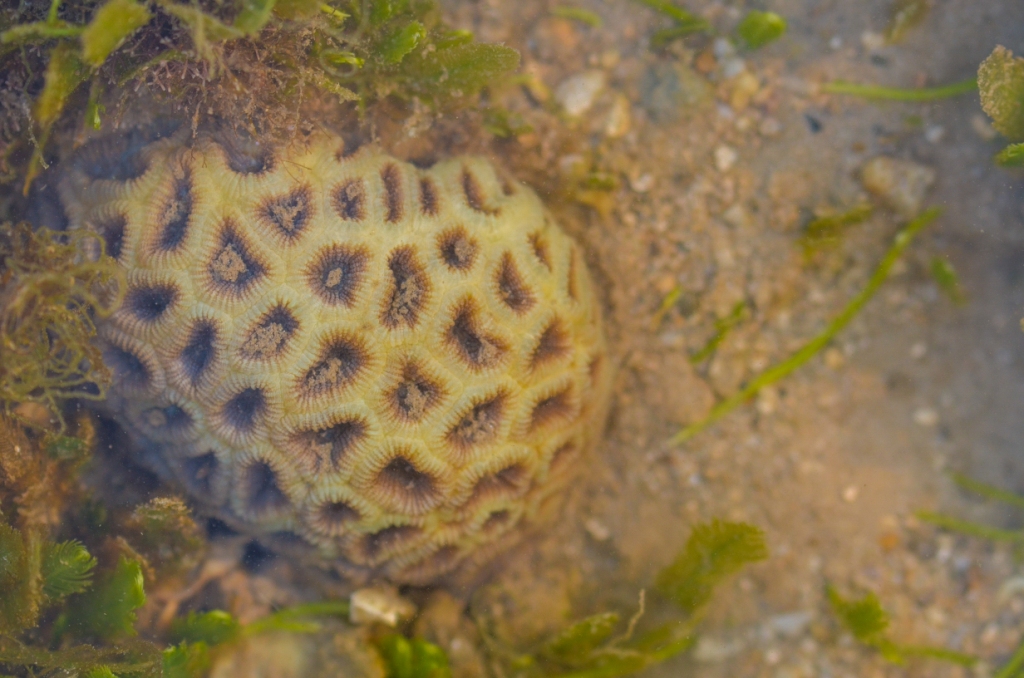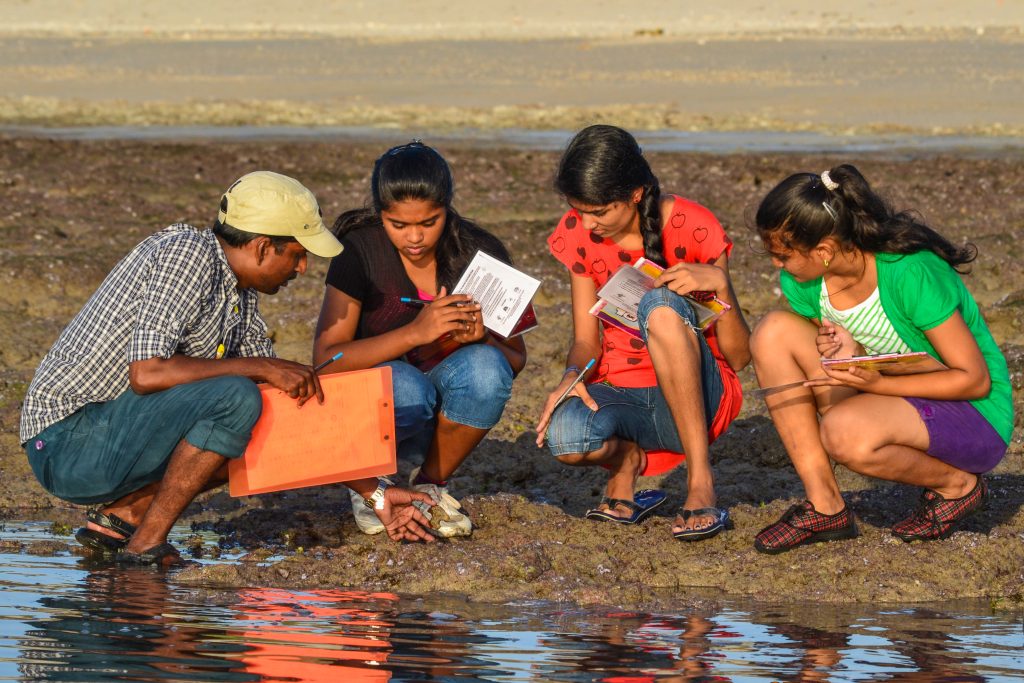The Alarm Bells of Coral Bleaching
Coral reefs, often referred to as the “Rainforests of the Sea”, are unique and vibrantly coloured ecosystems teeming with life. For most of us who have seen pictures of corals or seen live corals, a question that pops up is – How are they so colourful? The breathtaking colours of the corals are not a matter of chance. The colouration has a robust scientific and ecological basis to it. Corals as we see them, are formed by the calcium carbonate skeletons of tiny marine invertebrates called coral polyps. These polyps live in symbiosis with microscopic algae known as zooxanthellae. This alga provides the coral polyps with energy through photosynthesis and the vibrant colours of the coral reefs are a direct result of the pigments within these algae. Therefore, this alga is the coral powerhouse: providing them with vibrancy, energy and colour.
Even though coral reefs occupy roughly only 1% of the sea bed, they provide habitat to a staggering 25% of marine life. They also act as natural breakwaters – protecting our coastlines from erosion caused by waves and storms. Besides ecological benefits, the reefs also support the livelihoods of coastal communities and contribute to tourism and an increase in fish aggregations. However, the coral ecosystem faces a growing threat: coral bleaching. Simply put, when ocean temperatures rise above a certain threshold, the corals expel the algae living within them causing them to turn white or pale, thereby causing “bleaching”. Bleached corals are stressed and are more susceptible to disease and mortality. If elevated temperatures persist for longer periods of time, the corals may die leaving behind a barren white skeleton.

Bleached coral from Mithapur, Gujarat | Photograph by B.M Praveen Kumar / WTI
Understanding the causes and consequences of coral bleaching is necessary for developing effective conservation strategies that can ensure their survival. The ongoing rise in global sea temperatures because of climate change is a primary driver of coral bleaching, posing a significant threat to the health and survival of coral reefs worldwide. In this context,
2024 is a very critical year for the survival of corals worldwide. The El Nino phenomenon which takes place approximately once in every two to seven years began in early 2023 and has been ongoing through 2024 as well. The warming of the oceans, instigated by the El Nino has been contributing to severe coral bleaching. According to the US – based National Oceanic and Atmospheric Administration (NOAA), the 2023 – 24 coral bleaching has been so significant that it has been categorised as a Global Coral Bleaching Event (GCBE) or mass bleaching. It is the 4th such global bleaching event after the previous three events which were recorded in 1998, 2010 and 2014 – 17. The GCBE – 4 of 2024 has impacted at least 67 countries and territories across the Atlantic, Pacific and Indian Oceans. Before the onset of GCBE – 4, GCBE – 3 which was recorded during 2014-17 was considered the most severe with 65.7% of the world’s corals experiencing bleaching. The current GCBE – 4 has surpassed the previous event with a staggering 70.7% of the corals worldwide being impacted by heat-induced bleaching since 2023.

Moon Coral in Mithaour, Gujarat | Photograph by Madhumay Mallik/WTI
India presently has four major coral reefs: Gujarat (Gulf of Kutch), Tamil Nadu (Gulf of Mannar and Palk Bay), Lakshadweep and Andaman and Nicobar Islands. The Mithapur coral reef of Gujarat also boasts of a remarkable biodiversity. With 28 hard coral species, 4 soft coral species, 5 species of seahorses, and an astounding 64 fish species, the reef offers a captivating array of fauna for researchers and marine enthusiasts to explore. This rich tapestry extends beyond animals, with a diversity of flora present as well, thereby making the Mithapur reef a critical habitat to conserve.
In 2008, the Wildlife Trust of India (WTI), Tata Chemicals Ltd. (TCL) and the Gujarat Forest Department came together to initiate the Mithapur Coral Reef Recovery Project in Gujarat. Initial surveys in the project area revealed that a mere 12% of the reefs were covered with live corals which was an alarming situation. This was coupled with other local stressors such as a heavy sediment load, algal assemblages and rising temperatures. A constant exposure to such local stressors demanded continuous monitoring of reef health and the best estimate of reef health can be made by taking bleaching as a proxy. Therefore, for almost a decade now, coral health monitoring has been regularly undertaken at the reef of Mithapur with the help of TCL employees, volunteers and school students as part of the projects’ citizen-science initiative. Colour-coded charts developed by the University of Queensland, Australia have been used to identify and quantify the amount of bleaching each year.

Colour-coded charts developed by the University of Queensland, Australia to record coral bleaching | Photograph by B.M. Praveen Kumar/WTI
With respect to the status of the corals in India, in light of the El Nino phenomenon, bleaching has been reported from Lakshadweep, the Gulf of Mannar & Palk Bay of Tamil Nadu and the Andaman group of islands. However, no significant bleaching has been recorded from the coast of Gujarat as of June 2024. Minor bleaching incidents (With 70% occurrence) and potential bleaching incidents (With >40% occurrence) are being recorded on average each year but the corals have recovered back to their normal health over time. Having said this, a severe bleaching incident was recorded during 2020-21 where almost 90% of the reef was affected by bleaching during the summer and monsoon months. However, the corals soon recovered by the end of the winter season.

Graph showing the intensity of coral bleaching from 2022 – 2024 in Mithapur, Gujarat
The above graph shows the regular reef health monitoring data from Mithapur from July 2022, July 2023 and June 2024. Bleaching is gauged by how light or dark the colour of the sampled coral is. The lighter/whiter the coral, the more bleached it is and the darker the coral, the healthier it is; retaining its original colour and composition. The three graphs indicate the frequency of distribution (%) of the sampled corals across the different colour categories where 1 is the lightest and 6 is the darkest. As can be seen from the three graphs, the frequency of occurrence of corals in the healthier categories (With a colour score of 3 and above; that is, 3-6) is higher in June 2024 than observed during July 2022 and July 2023. As of June 2024, the potential bleaching risk of the reef of Mithapur was estimated at 21.9% with an average colour score of 3.1 (On the colour-coded charts to gauge the intensity of bleaching), indicating that the El Nino of 2023 and the subsequent GCBE-4 has not impacted the reef of Mithapur yet.

Coral reef monitoring by TCL volunteers | Photograph by Altaf Bhaya/WTI
To conclude, as we race against climate change and combat rising oceanic temperatures, robust and continuous monitoring of the marine ecosystem is essential to ensure the survival of marine species. Regular monitoring will help ring alarm bells if any discrepancy or deterioration in the health of the corals is observed and will help in instantaneously rolling out management interventions that might be required to assist the coral reef in returning to its healthy form.
Praveen heads the Mithapur Coral Reef Recovery Project in Gujarat, India









